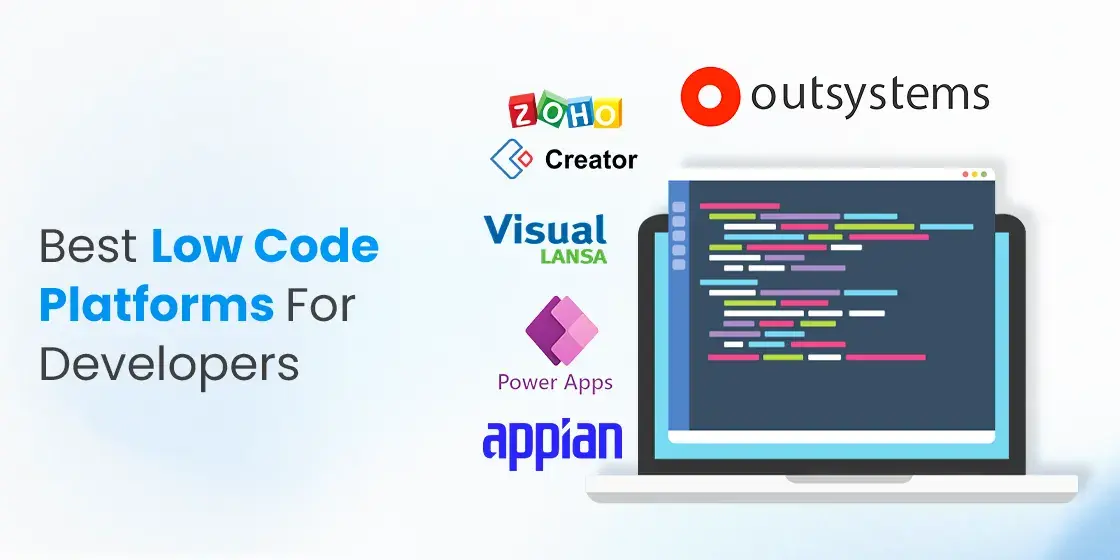Free Facts On Deciding On Low-code platforms for application development
Free Facts On Deciding On Low-code platforms for application development
Blog Article
The Benefits Of Low-Code Development For Non-Developers In Terms Accessibility
The following main factors make low-code programming accessible to those who are not developers.
Drag-and-Drop Builders: Low-code platforms have drag-and-drop interfaces which allow non-developers to design applications without having to write code. This makes it easier for those with less technical background to participate in the development process.
WYSIWYG editor: The "What you see is the result you get" editors allow users to design interfaces, workflows and other features in a manner that is similar to the final outcome. They are easy to learn and use.
Simple Workflow and Logic Design:
Visual Workflow Modelling: Users are able to develop business processes, application logic and flowcharts using models and visual flowcharts. These methods are more intuitive than the traditional methods of coding.
Low-code platforms typically have pre-built logic elements (e.g., conditional statements loops, conditional statements) which can be easily configured, reducing the requirement for complicated coding.
Reusable Templates and Components:
Library of Templates pre-built: Many platforms that offer low-code also have a library of template types that are suitable for most applications. This allows developers to start quickly and efficiently while non-developers are able to customize the templates as they see fit.
Reusable modules and widgets Utilizing modules or widgets that can be reused users can streamline the process of creating them by reducing the requirement for detailed technical knowledge.
Tutorials for Guided Development and Guided Development
Step-by -Step Instructions: Platforms usually provide tutorials on screen, guiding development routes and other tools to help people who are not developers to create applications.
Interactive Tutorials: Interactive and hands-on tutorials allow users to learn through doing. They gain confidence by using the platform.
Integration with existing tools:
Seamless Integrate: Low code platforms are designed to seamlessly integrate with the existing systems and tools in business (e.g. the ERP or CRM) This lets non-developers to develop applications that work with current workflows.
APIs connectors and APIs: These devices make integration easier by allowing non-developers (or even users) to link their applications with external services.
Collaboration Features:
Team Collaboration - Features such as real-time team collaboration and shared workspaces enable non-developers to collaborate with analysts, professionals, analysts, and others.
Role-based Access Control: Non developers can be assigned specific roles, with appropriate access levels. This lets them participate in the development process without compromising security and functionality.
Automated Debugging, Debugging, and Testing
Test Tools Included: A lot of low-code platforms include built-in debugging and testing tools. These tools automatize the process, making it easier for non-developers to ensure their apps are functioning properly.
Error Highlighting When errors occur the platform highlights them and suggests solutions. It assists non-developers with solving the issue.
Development using low-code is easier for non-developers to access because it democratizes the development process. Low-code platform platforms empower business users with intuitive, visual and guided tools. They can then actively participate in developing and maintaining applications. Follow the most popular see for Low-code Platform for application development for blog recommendations including build a docker container, ms azure sql, azure sql databases, application modernization, app modernisation, rad development, rapid application design, push alerts, cloud software applications, application development platforms and more.
The Advantages Of Low-Code Development For Governance And Security
Low-code development of apps offers numerous advantages for governance and security. This is essential to ensure that apps comply with the regulations, are secure and are well managed throughout their life. Here are a few of the most important advantages:
Unified Management Console: Low-code platforms offer a central management console that allows administrators to manage and oversee the entire application. This ensures consistent governance across the company.
Role-Based Access Control: These platforms offer robust role-based access control that allows administrators to define rules and enforce these policies. Only authorized users are allowed to modify and access certain areas of the application.
The Compliance Process and Regulatory Adherence:
A lot of low-code platforms come with built-in security features for compliance. They're designed to meet the requirements of industry standards and regulations, such as GDPR and HIPAA. They offer templates and tools to ensure that applications comply with these standards.
Audit Trails: Many organizations integrate comprehensive logging and audit trail systems, which enable them to keep track of changes as well as track access, and ensure that they are in compliance with internal as well as external rules and regulations.
Additional Security Measures
Data encryption: Low-code platforms often offer built-in data encryption both in transit and at rest. This means that sensitive data is secured.
Security Certifications: Many companies of low-code services have security certificates such as ISO 27001 or SOC 2 which prove that they adhere to high standards. These certificates provide an additional level of security to customers.
Automated security updates:
Regular Updates and Patches Low-code platforms typically are equipped to handle security patches and updates regularly. This means that apps are protected against the most recent threats, without developers having to manually alter their settings.
Security Monitoring: Continuous monitoring of security tools are typically included, providing real-time alerts as well as insights into potential security issues.
Data Governance:
Data Access Policies: These platforms permit organizations to define and enforce data access policies to ensure that data is accessible to authorized users and is utilized in a proper manner.
Data Masking and Anonymousization The tools built into the system to hide and anonymize data helps secure sensitive information in testing and development environments.
Consistent Application Management:
Pipelines for Development and Delivery Low-code platforms typically include integrated development pipelines as well as delivery pipelines which incorporate security checks. Security is assured throughout the entire lifecycle.
Version Control - Integrated version controls help track modifications to applications, and permits them to be reverted in the event of need. They also ensure the integrity and performance of the application.
Authorization and Authentication of Users:
Single Sign-On (SSO) Single sign-on support and other advanced authentication mechanisms simplifies user management and enhances security.
Multi-Factor Authentication - Many platforms can support multi-factor Authentication that adds an extra layer of security when logging into applications.
Policy enforcement and Compliance monitoring:
Low-code platforms come with policies that are predefined to aid organizations in implementing security and governance guidelines.
Tools for Monitoring Compliance: These tools provide regular monitoring and report about compliance levels, which makes it easier to identify and address possible issues in advance.
Integrate with the existing security infrastructures:
Seamless integration: Low-code platforms are able to be seamlessly integrated with existing security tools and systems like firewalls, SIEM products (Security Information and Event Management), and identity management systems.
API Security: Built in API security features safeguard information, guarantee integrity of the application and ensure secure integrations.
Training and the best practices
Guided Best Practices: Many platforms offer guidelines and best practices to help non-developers comply with security standards.
Some lowcode providers offer tools and security education for users to understand how to create and maintain secure applications.
Overall, the governance and security advantages of low-code application development assure that the applications are developed and operated in a secure, compliant, and controlled way. These platforms provide all the tools and frameworks necessary to safeguard sensitive information and enforce policies while maintaining regulatory compliance. Check out the top Legacy application modernization with Low-code for blog tips including multiplatform mobile app development, software for app development, application development platforms, cross platform app development, app development platform, rapid application design, paas service, low code platforms, cross platform app development, push notifications android and more.
The Benefits Of Developing Applications Using Low-Code For Collaboration And Workflow
Low-code application development offers several benefits in collaboration and workflow, making it the perfect choice for businesses looking to enhance team productivity and speed up development processes. Here are a few of the advantages.
Unified Development Environment: Low-code platforms offer a unified, single environment in which all team members, including business analysts, developers designers, and others, can collaborate efficiently. This eliminates silos.
Visual Development Tool: The drag and drop nature of platforms that use low-code technology makes it easy for team members who aren't technical to be involved in the process of developing. They will make sure that the business's requirements are accurately analyzed and implemented.
Enhanced Communication
Real-Time Collaboration: A lot of low-code platforms offer real-time collaboration capabilities including the simultaneous editing of comments, and instant feedback, which enable continuous communication and cut down on the time wasted in back-andforth discussions.
Shared Workspaces Teams can collaborate by sharing workspaces. They can use these workspaces to edit, view and discuss elements of the project.
The streamlining of workflow management
Tools for managing projects built-in to the platform: Low-code platforms are often equipped with project management tools integrated that allow teams to plan, track and oversee their projects. This includes the management of tasks, tracking progress and deadline management.
Workflow automation: Automating repetitive workflows and tasks decreases errors and manual work, allowing teams and individuals to concentrate on strategic projects and increase efficiency.
Speedier Iteration Cycles:
Rapid Prototyping: Low-code platforms enable rapid prototyping and iterative design that allow teams to design prototypes, test, and refine applications in shorter cycles. This provides rapid feedback and improvements.
Agile Development Support Agile Development Support: Support for agile methods allows teams to work in sprints, continuously offering small increments of functionality, making it easier to adapt to evolving requirements.
Accessibility for Non-Developers
Citizen Development: Low-code platforms allow business users the ability to design and edit apps without coding expertise. This frees IT and Development teams of burdens and gives them the ability to respond faster to business requirements.
Training and Onboarding - Intuitive interfaces, extensive training materials and user-friendly interfaces make it simple for new team members to get up to speed and improve the overall team's cooperation.
Centralized Documentation & Knowledge Sharing
Integrated Documentation: Low-code platforms usually include features to create and maintain documentation within the platform itself and ensuring that all information about projects is centralized and easily accessible.
Knowledge Repositories Teams can create and maintain repositories for knowledge which include best practices templates, templates and reusable elements, facilitating the sharing of knowledge and reducing duplication.
Consistency, Standardization and Standards:
Standardized Components. Standardization of components across different applications guarantees consistency and makes it easier to work and be understood the team members.
Governance and Governance and Compliance: Built-in frameworks for governance ensure that each development follows the organizational guidelines and regulations, reducing the possibility of non-compliance as well as making sure that the applications are in compliance with quality standards.
Feedback Loops and Improvement Loops
Integrated Feedback Low-code platforms offer users with feedback mechanisms integrated into them which allow them to give users with feedback quickly on their applications. This feedback can be later integrated into the application development process.
Continuous Improvement: The capacity to quickly test and then deploy changes in response to feedback allows for constant improvement of software. They are in close alignment with the needs of users and goals of the business.
Visualization, Reporting and Analysis
Real-Time Analytics built-in analytics and reporting tools give real-time insight into the progress of projects, their performance and user interaction, enabling data-driven decision-making.
Visual Workflow Analysis: Visual tools are used to map processes and workflows. These tools aid teams to determine and improve their workflows.
Low-code app development offers many benefits for collaboration and workflow. These include the ability to bring different teams together in one space, simplify communication and processes, and automate some of them. This helps create a more agile, collaborative and efficient environment for development. This eventually results in better-quality applications and better alignment of business objectives.